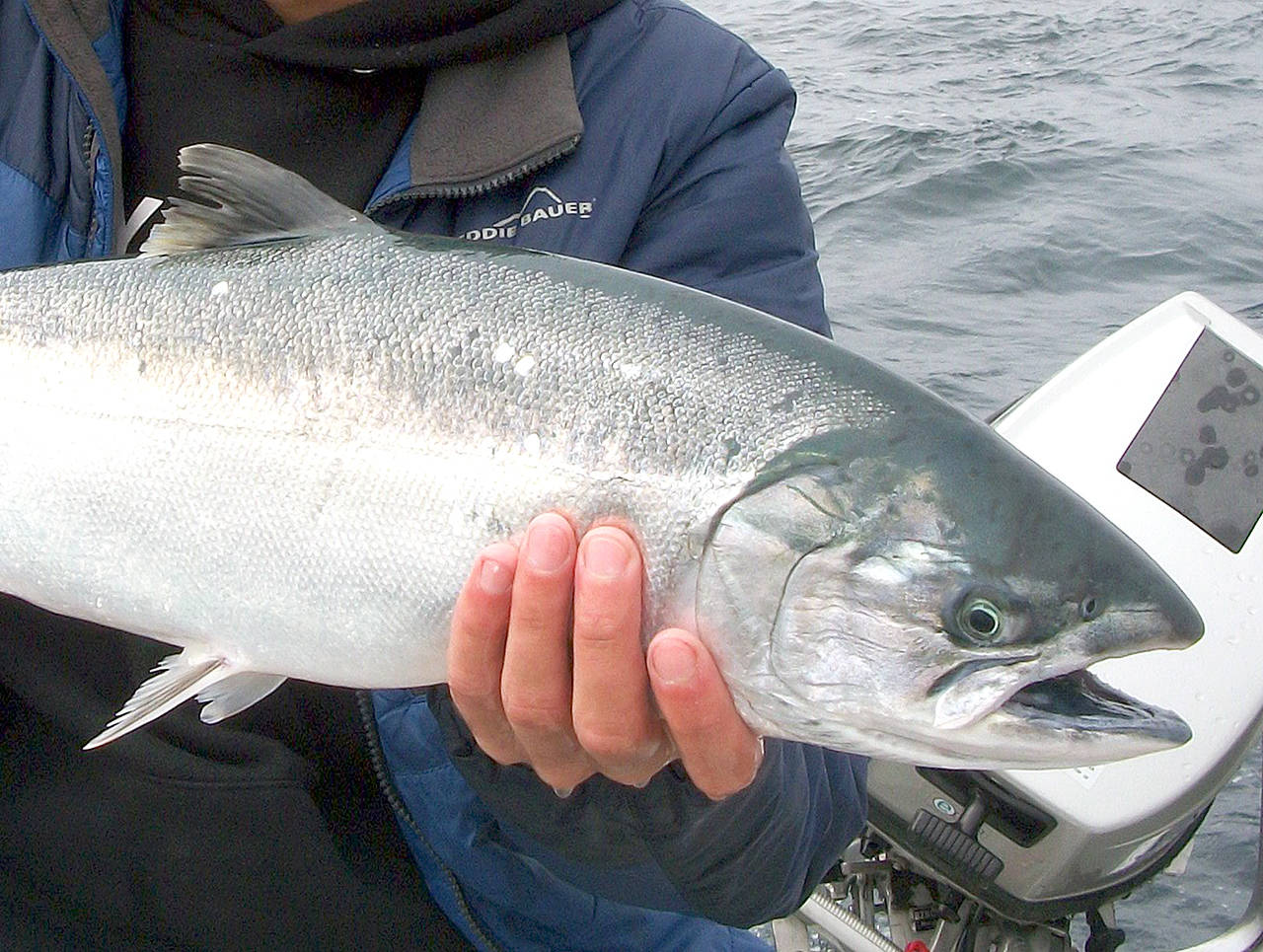NORTH OF FALCON, the annual salmon season setting process in which federal, state and tribal fishery managers plan the area’s recreation and commercial salmon seasons, gets going in earnest with the state Department of Fish and Wildlife’s statewide salmon forecast meeting on Wednesday.
The meeting will be held from 9 a.m. to 3 p.m. at the Lacey Community Center, 6729 Pacific Ave. SE, in Olympia.
Initial forecasts compiled by state and tribal biologists of the 2019 salmon returns will be presented.
These forecasts have not been released, but early projections point to a better coho season this summer and fall.
“It is looking pretty good for coho, and let’s just hope that the Queets River or another coastal run doesn’t prevent us from accessing them,” said Wendy Beeghly, the WDFW coastal salmon manager. “It’s a long process but we’ll see what we can carve out for fishing seasons.”
Queets River and Strait of Juan de Fuca coho stocks are both designated as “overfished” by the National Oceanic and Atmospheric Administration.
This designation means a salmon stock’s actual spawning escapement averaged over a three-year period (specifically, the geometric mean of the most recent three years) falls below the level specified in the Salmon Federal Fishery Management Plan.
This term is used regardless of whether fishing was the cause of insufficient escapement or other factors are subsequently determined to be the primary cause.
An overfished determination indicates that the stock is depressed and signals conservation concern.
Oregon index positive
A positive for coho is a much larger preseason prediction of coho salmon returns in the Oregon Production Index — an annual prediction of coho salmon returns to the Columbia River and coast.
For the first time in many years, the predicted coho returns total more than 1 million at 1,009,600, compared to a 2018 forecast of 349,000 and an actual return of 230,700.
The 2019 prediction includes a 933,500 hatchery coho forecast, 905,000 of which are predicted to enter the Columbia River.
Those numbers point toward plenty of rewarding recreational fishing opportunities off the coast and in West End river systems this summer and fall.
Observations
Before any of these numbers were released, Quilcene’s Ward Norden, a former fisheries biologist and owner of Snapper Tackle Co., sent along some observations on 2018 ocean conditions that he believes will impact the upcoming salmon seasons.
“One of the reasons I have not done my annual salmon return projection so far this winter is that the conditions for the salmon and especially out-migrating coho smolts last year were very unusual,” Norden said. “Last summer, the deep ocean nutrient-rich current that feeds the food chain in the Strait of Juan de Fuca and Puget Sound all the way to Tacoma was the strongest and most active in my 35-plus years of observations.
The Strait, all the way out to 50 miles north and west of Neah Bay, was extraordinarily rich with food for happily feeding young salmon if the fish stayed close to take advantage.”
Norden emphasized the if, in that last sentence.
“Ocean conditions for plankton growth south of Cape Flattery and north of Ucluelet, B.C. were not nearly so good,” he said. “If our salmon smolts and juvenile chinook strayed to Alaskan waters or south, they probably experienced high mortality.”
The optimistic initial coho numbers dovetail with what Norden said earlier this month.
“What I do know is that this will be a great year for resident coho this summer, fatter than normal blackmouth this winter and improving runs of spring and summer chinook to the Columbia River starting this year plus for the next three,” Norden said.
“The Snake River chinook that use the waters near Neah Bay as their feeding grounds will do particularly well.”
This led Norden to say that sport fishers will enjoy a much better year at Neah Bay.
And it’s good news for Makah commercial operations.
“For my friends in the Makah commercial fisheries, this active deep ocean current is particularly good news for the commercial sockeye fishery their economy depends on,” Norden said.
Season-setting meetings
Fish and Wildlife has scheduled more than a dozen meetings around the state to discuss the salmon-season setting process, including a meeting in Sequim on March 21.
A “Puget Sound Recreational Fisheries Discussion” is planned for the March meeting of the North Olympic chapter of Puget Sound Anglers. The meeting will be held at Trinity United Methodist Church, 100 S. Blake Ave., from 7 p.m. to 9 p.m.
North of Falcon meeting
A public meeting to present results of state-tribal negotiations and analyses of preliminary fishery proposals will be held from 9:30 a.m. to 5 p.m. at the Lynnwood Embassy Suites, 20610 44th Ave. W., in Lynnwood.
With public participation, preferred options are developed for Puget Sound sport and commercial fisheries.
A plenary session between state and tribal co-managers also is planned. That session also will be open to the public.
The Pacific Fishery Management Council, responsible for establishing fishing seasons in ocean water three to 2o0 miles off the Pacific Coast, is expected to adopt final ocean fishing seasons and harvest levels at its April 11-15 meeting in Rohnert Park, Calif.
The 2019 salmon fisheries package for Washington’s inside waters [Strait of Juan de Fuca, Puget Sound and river systems] is also expected to be completed by the state and tribal co-managers during the PFMC’s April meeting.
________
Sports reporter/columnist Michael Carman can be contacted at 360-417-3525 or mcarman@peninsuladailynews.com.

